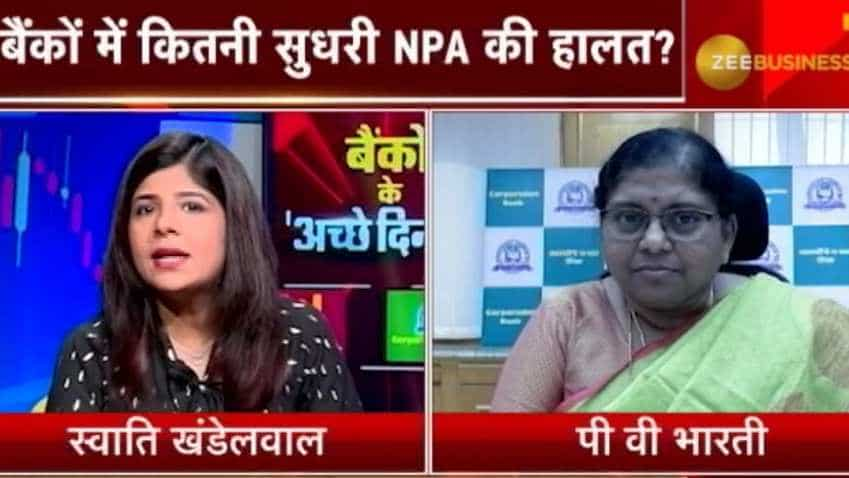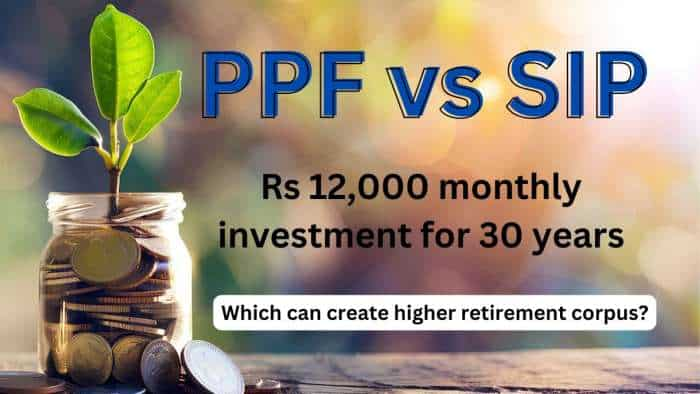Corporation Bank's credit levels will increase by 10% in FY20: PV Bharathi, MD & CEO
Liquidity is available with us and the banks are ready to lend. We have got funds as far as our liquidity position is concerned, we are comfortable with it and are ready to lend. Demand for the loan has increased in small pools like the retail loan, housing loan, vehicle loan, MSME loan and agriculture loan, as the sowing season has started.

PV Bharathi, Managing Director & CEO, Corporation Bank, talks about the liquidity, sanctioning of loans to corporate and MSMEs, merger and NPA levels during a talk with Swati Khandelwal, Zee Business.
Edited Excerpts:
Q: Has banking sector concerns including liquidity issues have come to an end?
A: Liquidity is available with us and the banks are ready to lend. We have got funds as far as our liquidity position is concerned, we are comfortable with it and are ready to lend. Demand for the loan has increased in small pools like the retail loan, housing loan, vehicle loan, MSME loan and agriculture loan, as the sowing season has started.
Q: But the corporate world and MSMEs are saying that they are facing problems and they are not getting funds as banks are a bit reluctant while lending. What is your view on this?
A: SME is a focus area for every public sector bank, today, and there are several schemes like Mudra and Stand-Up India to support them. Ever, there is a working capital limit for general MSME borrowers. As far as the banks are concerned, we have our branches across India and each of them is offering loans to MSMEs. For instance, a loan from Rs50,000-10 lakhs is offered under Mudra loan. In the case of Stand-Up India, we are focusing on new greenfield projects. Similarly, a PSB 59 minutes scheme has been introduced to support MSMEs under which every application are placed in it. This suggests that there is a pick-up. Credits are being sanctioned as per there need.
Q: What is your view on NPA and asset quality?
A: Several public sector banks were under the PCA between March 2018 and March 2019 but capital infusion has helped many banks to come out of the list. All these banks are ready to lend and there is an improvement in their capital adequacy ratio (CAR). On average, the provision coverage ratio (PCR) of the banks has reached 75% mark and this has helped in taking the net NPA control to about 5% levels. There is an improvement in these financial indications because capital has been provided to every bank. The capital was allocated under the BASEL III norms after accessing the capital requirements of every bank and this will enable us to be ready for further credit.
Q: Update us on the recoveries and credit growth of the bank after it came out of the PCA? Also, provide an outlook for the bank?
A: Our net NPA stood around 11.34% and the gross NPA was 17.34% in the past. However, the capital infusion of Rs9,000 in February 2019 helped us in improving our provision coverage ratio and bringing down our net NPA below 6% levels. This helped us in being out of the PCA, post which the bank started focusing on Capital to Risk (Weighted) Assets Ratio (CRAR) and focus mainly on retail loans and advances. Nowadays, we are trying to bring down the ratio of retail loans to individuals, agricultural loans and MSME loans (RAM) and corporate loan stands to 60% and 40% respectively and we have made progress on these parts. The RAM has improved to 53% and we expect that it will reach 60% levels by March 2020. Normally, retail loan demand increases in the last nine months of the year. The maximum retail loan demand - in form of home loan, vehicle loan and personal loan - rises mainly between August 15-January 26, which is termed as festival offer and is a time when the banks reduce their rate of interest and processing charges and there is an offtake. Like every year there is a retail offtake this year too and there is an improvement. There is an improvement in our retail home loan and vehicle loan. The agricultural loan is the second thing and sowing season has just begun and we will try to contact the farmers for renewable of their agricultural loans and encourage them for a fresh agricultural loan. Besides, there is an improvement in a jewel loan too. As far as MSME is concerned then the government is encouraging us towards the MSMEs and all proposals are being forwarded to the PSB 59 minutes scheme and there is a surge in it.
Q: You are saying that there is an uptick in home and vehicle loan but the on the ground situation is saying a different story. So, can you explain this mismatch?
A: There were a lot of unsold houses in the real estate sector while the banks are providing loans for projects that have been completed and are ready to move. We are not encouraging new projects that will be completed in the next 3-5 years. The loans are being provided for ready to move homes to make sure that the customers can occupy the homes with immediately and start repaying it. There is an increase in this segment. When it comes to vehicles then you would have seen that old stocks are being cleared and we are waiting to see the loan offtake for BSVI compliant vehicles. But, if you see all across the country in various branches then the offtake has been good.
Q: Corporation Bank in RBI's diversion report reported an NPA by more than Rs63 lakh in RBI Assessment. Can you please share the details of the same with us? Do you feel that certain sectors are under stress, if yes, then name those?
A: This time, the diversion was very less. As SLBC decides on special dispensation for restructuring in the agriculture sector by looking on the drought and flood-hit areas. They in their suggestion have asked us to provision the areas where our liability has increased despite they were restructured 2-3 years back. For the purpose, they have asked us to provision at least 2-5% of our entire portfolio. The remaining 1-2 accounts provided by them were provisioned in June and September. So, the diversion report is related to the previous accounts. The third is related to valuation in which complete details have been provided and we are trying to reduce it too.
Q: Update us on the amalgamation process of the Corporation Bank and Andhra Bank with Union Bank?
A: The amalgamation committee has approved it and the process of amalgamation has started. Going ahead, a consultant will be appointed, the valuation process will be started and the grievance committee will be formed to look into the issues of the shareholders. Corporation bank is an amalgamating bank, while anchor banks are more responsible as they are supposed to perform several works. As an amalgamating bank, we are responsible to create a valuation of the bank and perform its due diligence tasks. And, the process has started at our end. As far as the anchor bank is concerned then they have constituted 30 committees in which various GMs are discussing on the policies, system and procedure of different banks. The committee has already met three-four times till date and is trying to make sure that the amalgamation process is completed successfully.
Q: Talk about the synergies and benefits that will prop up for the shareholders after the merger process is completed? Do you think the merger will unlock the intrinsic value of the bank?
A: If you have a look on March 2018 and March 2019 vis-à-vis then we earned profit in June and September. The March 2019 decisions were made to get out of the PCA and recoup the loans and other activities to move towards progress. We were in profit in June and September. Interestingly, our overall business has increased and we have seen growth in deposits and advances. The quality of advances has improved. Risk-Weighted Assets (RWA) is the most important factors, where NPA can be brought under control. That's why the new advances are being contracted very carefully by taking A and triple A accounts into consideration. The process has helped us in bringing down the RWA levels to a great extent. This helps us in improving our asset quality and we are reaping the benefits of the capital that we have at present.
Q: It means that things will turn better after the merger?
A: We expect the recoveries through the resolution of the NCLT cases will improve our profitability. One case has been resolved and 2-3 more cases are likely to be resolved soon. These resolutions will give a good shape to our March 2020 financials and this is why our prices have gone up and have almost reached the book value mark. Further, when we will create the valuations and ratios of the bank then they will stand firmly, which means our shareholder will get a good value on their value.
Q: What is the capital situation of your bank? Do you think that you will need more funds despite the recapitalisation was announced by the government, if yes, then how it will be raised?
A: Corporation Bank's CRR is at a comfortable level and we are quite above the required norm that is 11.5% but we are standing at 12.30% at present. Our CET-1 ratio is also at a comfortable level. There is no requirement for any new capital at present. And, we will have to look forward towards the capital requirement in March 2020 and if we feel that more capital is required then I think we are capable of raising around Rs500-1000 crore of our own. However, it is very difficult to get any more capital from the government as it has a shareholding of around 93.50% in the bank. But, we are adequately capitalised for the projection that we have done for March 2020.
Q: Verdict on Essar Steel will have a positive impact on the banking sector. What is your bank's exposure to the company?
A: Rs1,300 crores will be recovered from Essar Steel.
Q: Do you think that more accounts apart from Essar Steel will come for a resolution, if yes, then what can be the quantum of recovery will happen from them?
A: We are targeting another 3-4 companies and are expecting a recovery of around Rs7,000 crore from them.
Q: What is your bank's exposure in the telecom sector that is going through an interesting phase at the moment?
A: Our exposure is almost negligible in the telecom sector and that's why it will not have any major impact on us.
Q: Tell us about Corporation Bank's exposure in the power and infrastructure sectors and the kind of recoveries that will be made from them?
A: We do have our exposure in infrastructure sector but it has been brought under control to a great extent. Interestingly, we haven't created any new exposure in the sector in the last 3 years. We have a focus on CRR and RAM as a present instead of corporate, especially in the infrastructure side.
Q: What are your target for the bank and what is your view on the turnaround story that you have created at the bank?
A: From almost March 2016, we have been trying to relook at the type of asset that we are contracting and you will find that it has improved a lot in these three years. The risk-weighted asset in the only indicator that is used to define the asset quality at our end and we mainly focus at the capital expenditure that will be made on the risk-weighted asset to find out that the capital consumption will give proper profit to us or not. The process has helped us to bring our risk-weighted asset down to 70-80% from 96%.
Q: Several banks are focusing on core asset and selling out the non-core assets. Do you have such assets that will be sold, if yes, what are the plans and what amount will be collected from it?
A: We don't have any subsidiaries except CorpBank Securities. However, we have tie-ups in case of insurance and other things, where we do third-party selling and cross-selling for our customers. But, we don't have any stake in them.
Q: RBI is working on stressed assets fund. Can you update us the plan and its quantum? What is the bank's view on it?
A: There is a need to complete real estate projects. Many people have taken home loans from the banks and are not able to repay it because they haven't received their homes. That's why they are floating tenders to complete the construction work of those projects and we are just trying to bring in people to complete it. But, it may fall short because we are not in a ready position to finance any new construction or completion of the projects. That's why the government has planned to bring an Rs25,000 fund to complete the incomplete buildings and hand them over to the owners. Its success will help us in reviving the NPAs in the housing loan. The process will give a boost to the real estate sector and the repayment of our loans.
Watch Zee Business Live TV Below:
Q: Any timeline for it and what are its modalities?
A: It is being discussed and can sometimes but it will be implemented soon.
Q: Where the bank's NPA and credit growth levels will stand by the end of this year?
A: I hope that there will be a 10% increase in credit growth and the way we move will help us in achieving our target. When it comes to NPA levels, then we have a target of bringing it below 5.5% by year-end and the ongoing process of recovery, monitoring of every account and control on slippages will help us in achieving the target. And, we have posted profitable results in the first two quarters and hope that we will end FY2020 on a positive note.
Get Latest Business News, Stock Market Updates and Videos; Check your tax outgo through Income Tax Calculator and save money through our Personal Finance coverage. Check Business Breaking News Live on Zee Business Twitter and Facebook. Subscribe on YouTube.
RECOMMENDED STORIES

Largecap PSU Stock for 65% Gain in New Year: Anil Singhvi picks PSU bank for long term; know reasons and target prices

Largecap, Midcap Stocks To Buy: Analysts recommend buying L&T, Tata Motors, 3 other stocks for 2 weeks; check targets

SIP in Stocks For New Year 2025: Market guru Anil Singhvi recommends 1 largecap, 2 midcap scrips to buy in dips; note down targets

SBI Latest FD Rates: PSU bank pays these returns to senior citizens and other depositors on 1-year, 3-year and 5-year fixed deposits
01:43 PM IST










 Union Bank of India reduces MCLR! Check full details of new interest rates
Union Bank of India reduces MCLR! Check full details of new interest rates Andhra Bank, Corporation Bank, Union Bank account holders? Your banks set to merge!
Andhra Bank, Corporation Bank, Union Bank account holders? Your banks set to merge! Sensex, Nifty rise; Bank Nifty sustains above 31K; Vodafone Idea, Corporation Bank, SpiceJet stocks gain
Sensex, Nifty rise; Bank Nifty sustains above 31K; Vodafone Idea, Corporation Bank, SpiceJet stocks gain Essar Steel Insolvency: SC quashes NCLAT ruling, clears ArcelorMittal takeover bid; SBI to PNB, bank stocks skyrocket
Essar Steel Insolvency: SC quashes NCLAT ruling, clears ArcelorMittal takeover bid; SBI to PNB, bank stocks skyrocket Corporation Bank cuts 1-yr MCLR by 5 bps to 8.85 pct
Corporation Bank cuts 1-yr MCLR by 5 bps to 8.85 pct